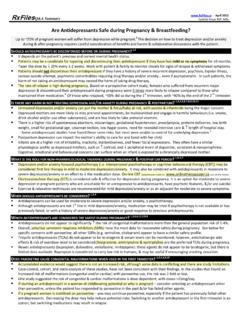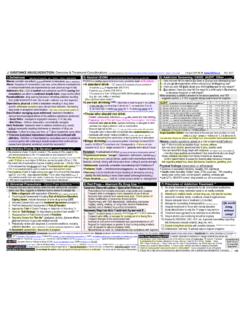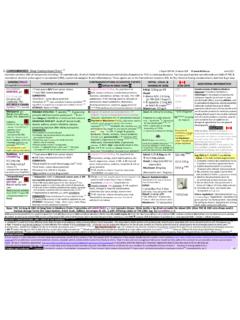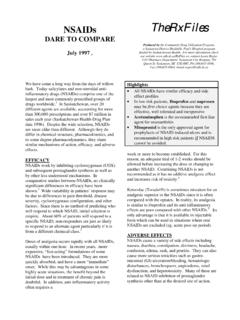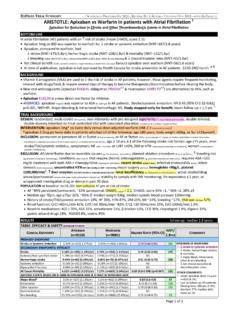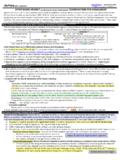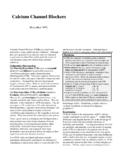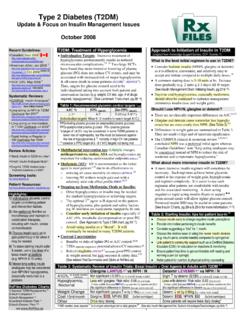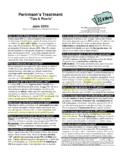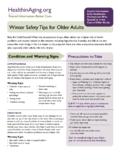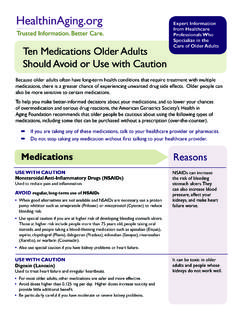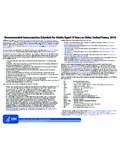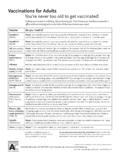Transcription of RxFiles Q&A Summary
1 RxFiles : Q&A Summary Oct 2013 Debbie Bunka Chronic Insomnia in older adults Sleep patterns naturally change as one gets older . Compared to younger people, older adults : 1,2,3 Sleep fewer hours & take longer to fall asleep Wake up more often during the night & are more easily disturbed by light, noise, pain, May not adapt as quickly to changes, such as a new bed Have changes in their sleep cycle, older adults spend less time in the most restful stage of sleep (less deep sleep) Result: tend to experience daytime sleepiness What is chronic insomnia?
2 4,5 difficulty falling asleep, staying asleep, waking up too early, or sleep that is non restorative. Sleep difficulty, lasting 1 month 3 nights/week, occurs despite adequate opportunity for sleep. Insomnia is clinically relevant if associated with significant distress or daytime impairment (fatigue, mood, cognitive, social/work dysfunction, ) Sleep & Aging: Quality is as important as quantity! 1,2,3, 6 Prevalence of insomnia in the elderly is estimated to be 40%. Although a mild deterioration in sleep quality may be accepted as normal with aging, a complaint of significantly disrupted nighttime sleep or impaired daytime functioning due to excessive sleepiness should be evaluated.
3 older people do not necessarily require less sleep, but they often get less sleep. hrs compared to hrs in younger adults . The sleep wake cycle in the elderly may be fragmented with interrupted nighttime sleep & daytime wakefulness interrupted by naps. The deep stages of non REM sleep (stages 3 & 4) are frequently reduced; REM sleep tends to be preserved. Table 1: Sleep Disturbance: Contributing Factors 7 MEDICAL CONDITIONS Optimize therapy of these contributing factors Anxiety BPH Cardiovascular disease Chronic kidney disease Chronic or acute pain COPD HF, nocturnal symptoms Dementia Depression Gastrointestinal ( reflux, peptic ulcer) Incontinence Malignancy Nasal Problems Nocturnal wheezing Parkinson s disease RLS/nocturnal leg cramps Seizure activity Sleep apnea Stroke Thyroid disease DRUGS Consider eliminating, or changing dose or timing of these agents.
4 May cause fragmented sleep, nightmares, nocturia, or stimulation Antidepressants, stimulating Buproprion, citalopram, duloxetine, escitalopram, fluoxetine, MAOIs, paroxetine, sertraline, venlafaxine Cardiovascular blockers (tamsulosin), agonists (salbutamol) blockers (propranolol, metoprolol), statins Decongestants Phenylephrine, pseudoephedrine Diuretics Chlorthalidone, ethacrynic acid, furosemide, hydrochlorothiazide, indapamide, metolazone, spironolactone; caffeine in combination products TYLENOL #3 Opioids Codeine, oxycodone (note if pain, opioid may sleep) Respiratory Salbutamol , theophylline, ipratropium Stimulants Amphetamine derivatives, caffeine, cocaine, ephedrine derivatives, methylphenidate, modafinil Others Acetylcholinesterase inhibitors ( donepezil)
5 , alcohol, antineoplastics, corticosteroids, levodopa, nicotine, medroxyprogesterone, phenytoin, thyroid supplements BPH=benign prostatic hypertrophy COPD=chronic obstructive pulmonary disease HF=heart failure MAOI=monoamine oxidase inhibitor RLS=restless leg syndrome Alzheimer s disease (AD) & sleep8,9 {see online extras for more info} It s easy to confuse the nocturnal behaviours of AD with insomnia. These will often present as more severe & exceed the limits of what might otherwise be termed insomnia in a non demented geriatric population.
6 Behavioural therapy should be tried before medication whenever possible. Insomnia in long term care settings10 Difficult to treat insomnia in this setting due to staff providing routine care that can affect sleep (turning bed bound residents every 2 hours, checking incontinent residents periodically at night, early morning vital sign measurements, etc.) Other problems: many residents have a roommate, doubling the interruptions. Residents may have little ability to make behavioural modifications given the environment.
7 Efforts to interruptions & noise in this setting, as well as a commitment to daytime activities, avoid daytime naps & minimize time awake in bed for residents would help reduce use of sedatives in older , frail adults prone to adverse effects. Approach to insomnia treatment Non pharmacological methods are essential for long term success (~75% of those treated will benefit11). Avoid the assumption that patients expect a sedative prescription and are unwilling to modify sleep related 31 Cognitive behavioural therapy (CBT) & pharmaco therapy, followed by CBT alone, may produce the best long term outcomes (6 week acute phase; 6 month follow up).
8 32 Follow up & reassess, as the relapse rate is high. Patient completed at home sleep diary can be used to identify areas for behavioural modification & for monitoring Sleep hygiene education (principles of good sleep habits) Insufficient evidence that sleep hygiene alone is effective in the treatment of chronic It is best used in combination. Avoid clock watching!! Set consistent bedtimes & wake times. Environmental control ( stimulus control below). Avoidance of nap, caffeine, nicotine & alcohol can affect initiation & maintenance of sleep continuity.
9 Cognitive behavioural therapy (CBT) 7,11,13,14 For 1 & co morbid insomnia Demonstrated efficacy in improving sleep onset latency & total sleep time (multi component therapies are more efficacious than individual techniques). Efficacy of CBT = benzodiazepines or zopiclone at 6 months Benefits of CBT are sustained for up to 2 years whereas pharmacotherapy loses benefit after drug discontinuation. Access to trained specialists & cost may be barriers. Brief behavioural tx ( 45min visit, 30min f/u, & 2 phone calls) & internet based CBT show benefit & feasibility in primary 34,36 Table 2.
10 Components of CBT Stimulus control therapy (reassociate bedroom with sleep onset) Go to bed only when sleepy Use the bed/bedroom only for sleep & sex do not watch TV Do not stay in bed longer than 15 20 minutes if unable to sleep Sleep restriction (limit time in bed that will lead to sleep deprivation to result in in homeostatic drive & sleep efficiency) Cognitive therapy (alters faulty beliefs & attitudes about sleep) Relaxation (biofeedback; promotes relaxation & arousal prior to bed) Relax muscles throughout body, breathing patterns, direct attention from everyday thoughts by using a mental focusing device that is neutral & repetitive generally considered feasible for application in primary care Exercise: small trial (RCT), community based older adults moderate intensity (30 40 min, 4x/wk, low impact aerobics/brisk walking).
